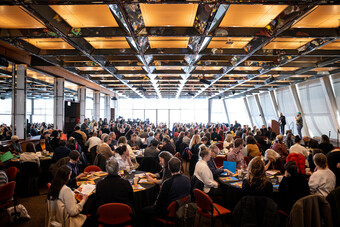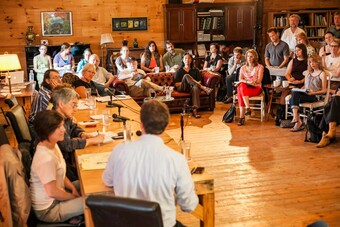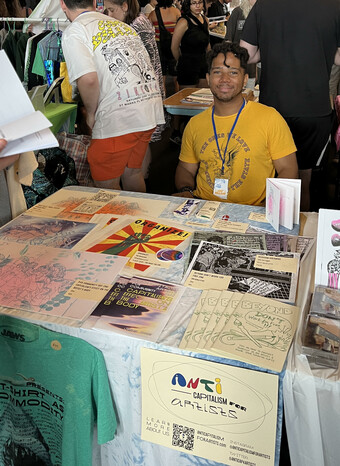Why Boards Don’t Need to Be Bored
New Challenges and Best Practices for Not-for-Profit Boards, part 3
This is part three of a three part series on not-for-profit boards.
Structure, Infrastructure, and Processes
Structure, infrastructure, and processes are an organization’s way of getting the work done. If the work changes, then the structures, infrastructures, and processes need to shift accordingly. The changes raised in the interviews I conducted with not-for-profit board chairs include not only a shift in mindset—from status quo to “How do we learn how to do this better? How can we learn to speak with strangers about substantive issues more effectively?” or even “How can we be provocateurs of civic discourse? How can we use theater to rebuild our democracy?”—to a shift in board/staff roles and relationships, an expansion of the criteria for new board members, and modifications to board structures and infrastructures.
Blurring the Lines Between Staff and Board
As noted earlier in parts one and two of this series generative issues are complex, often ambiguous, central to the organization’s mission and/or survival, and for which there is frequently no obvious right answer. Solutions to these issues require skills or information with which the organization may have little prior experience. Traditionally, these issues have been addressed by staff, but as complexity, ambiguity, and the rapid pace of change have grown, a broader range of skills, perspectives and experiences than those possessed by even the most accomplished theater leadership enhances the chance of an organization’s success.
One of the most enduring, and jealously guarded features of not-for-profit organizational life is the dividing line between board and staff. As boards take on a more proactive leadership role, there is an almost inevitable rubbing up against the traditional roles of the theater staffs—from the leadership on down. For some of the theaters, this seemed not to be a problem: according to board chairs, partnerships were the order of the day, with the leadership finding the input and expertise of the board chair and board members useful. Needless to day, some heads of theaters may not share this perspective. Nevertheless, for smaller theaters, or theaters with small staffs, there were several examples of staff actively using board members with special skills, (or other skilled non-board members) to work as part-time volunteer staff, or, having them work collaboratively with staff in their areas of mutual expertise. One board chair with extensive organizational and strategic planning experience, regularly coached the executive director, and there were additional examples of board members with particular skills coaching and mentoring junior staff.
One theater had a successful group of skilled volunteers who knew the theater well, and were able to extend the staff’s capacity in productive, non-competitive ways. Several board chairs echoed the comment that “A small staff means the board has to be engaged, not just in thinking and talking about things, but in implementation.” The key to success in these relationships lay in staff and board getting to know each other in ways that indicated mutual respect, a kind of “we’re all in this together,” and all working for the success of the theater. “I’m here to make sure all voices are heard,” one chair commented, and this seemed true in several of the participatory strategic planning processes, some of which were staff led while others were board led.
Generating Strategy and Casting a Board
There seems to be a growing number of examples of early, up front, significant board involvement in the strategic planning process. In several cases, board members with strategic planning expertise were drafted by staff to lead the organizations’ strategic planning processes; in other cases, there was a board/staff committee that led the process. It was interesting and heartening to note that regardless of who was in the lead, almost all the boards have been or are deeply involved in the actual development of the strategic plan. One organization had even received a generous grant to do its five-year strategic plan. Hopefully, board rubber-stamping of staff plans is on its way out!
Board involvement in strategic and generative issues has also had a noticeable impact on the criteria for new board members. The notion that board members are expected to do more than show up at a monthly meeting and write a yearly check is reinforced by these expanded criteria. One board chair commented, “We cast the board like you cast a play: diversity of skills, people who get the mission, people who have a relationship with the theater.” Possession of needed skill sets (e.g. the ability and experience to deal with print and other media, experience in strategic planning), the representation of different demographics (e.g. younger candidates familiar with social media and ways to engage younger audiences, people of color with local community ties, or retired people with skills and time), and an entrepreneurial mindset were increasingly key criteria for potential board candidates.
We cast the board like you cast a play: diversity of skills, people who get the mission, people who have a relationship with the theater.
And when board chairs reflected on which board members had been most successful, it was not those with deep pockets that came to mind; rather it was those who had a true passion for the theater and were committed to using their diverse skills to further the theater’s mission and success. “Passion! That’s our main criterion!” Another was availability of time. A few of the board chairs spoke of getting stricter about board attendance, and it was clear from the range of activities in which many of the boards are engaged that being an effective board member required a time commitment greater than just showing up at monthly board meetings. When asked about what this time commitment might look like, several chairs thought that some board members spent three to five hours a week on board activities.
One board developed a Trustee Participation Plan in which each board member agreed on what they were willing to be held accountable for that year. For another board, three board vice presidents are responsible for keeping in regular touch with eight to ten of the board members, and there are a growing number of boards in which board members are evaluated yearly, based on board-wide and/or individual goals that have been mutually agreed to. It is also important to note that the commitments made by the board members in these plans are for more than just a dollar fundraising goal. Some boards have even developed simple “dashboards” for evaluating progress toward goals.
New Ways of Working
Executive Committees (ECs), convened by the board chair, play an increasingly important role in creating board agendas, and several chairs told me, with more than a touch of pride, “Our board meetings have very little in the way of presentation. It’s all discussion. Everyone reads the board packet beforehand.” One EC meets two weeks before each board meeting to develop the agenda; another meets monthly, or more often if necessary. From an administrative or agenda perspective, consent agendas are being more widely used, all staff and committee reports are circulated well before the meetings, and board members are getting better at reading staff reports and communications before coming to the meetings.
One board starts every meeting with a board member story about why they are involved. This sets the tone, and connects people to the mission, the art, and each other, and in a number of the board meetings, forty-five minutes to an hour may be set aside for the discussion of a single issue. Several boards assess progress on their plan every month, and one board is working on the development of a set of benchmarks to measure progress on the strategic plan. Measuring progress on goals appears to be increasingly important. “If we don’t have the information in a timely fashion, we won’t be able to fix problems before they become crises.” One theater who ultimately weathered a financial crisis devoted several board meetings to looking at the whole organization systematically, spent time learning how to “tell a better story”, and implemented a range of “preventive infrastructures and processes.”
Annual retreats have also become a regular part of the board infrastructure, with retreats lasting from a half day to overnight. Most boards engage an outside facilitator, and agendas include interesting speakers, team building exercises, and interrogations of the mission. One board staged a mock mission debate between the artistic director and executive director to explore different approaches to growth, while another devoted the entire retreat to one key issue. A focus on evaluating “how we are doing as a board, what should we do more of or less of,” was common, as was making explicit what they had learned so it could be folded in to future actions. One board did not do a major evaluation at the retreat; rather they did post mortems on each production as they went along.
While fundraising and board giving are core issues for every theater, it was not as prominent a feature of board involvement as I had expected. One board supported doing an economic impact survey that documented how much money the theater was bringing into the community, a report that helped with their annual funding appeal to the state legislature, but the concept of a partnership between staff and board in actual “asks” to potential major donors or foundations is not yet widespread, perhaps because many board members are still uncomfortable in this role. Nevertheless, several boards, as a result of their generative work on reaching new audiences, or their commitment to support new work, and based on the newly developed shared stories about the value of the theater, are experimenting with making prospective donor asks for specific funding—to “make the theater more accessible,” or “to enable us to increase what we pay our artists”—rather than the generic annual fund drive.
Some of the theaters are also experimenting with structural changes. One theater’s Audience Connectivity Working Group has become part of its organizational structure, supported by two new staff members. Reflecting a shift in how the board is thinking about reaching new audiences, it is notable that these new positions do not report to the marketing department; rather they are using many of the classic community organizing approaches to engage their audience in the whole artistic experience. Another theater, a summer festival, is using a network of volunteers as a means of not only engaging people, but as a way to supplement their small staff. To address issues related to bringing in new audiences and cultivating potential new board members, several boards are also experimenting with infrastructures, such as a Friends of the Board group, an Advisory board, or a “Friend Raising” campaign. The importance of the website as a critical infrastructure is also increasing, with active social media programming, Facebook posting, and tweets.
Continuing Challenges
But there are additional challenges that came up in almost every interview. “We still haven’t gotten ahead of the train on the space problem,” lamented one board chair, a refrain I heard from many others. Other issues emerged in almost all the interviews: “How to more successfully break into the corporate world?” “How to focus simultaneously on both short term and long term issues?” And boards are looking at the need for serious succession planning—a brewing problem as many of the theaters are still founder led—with a number of founders nearing retirement age. Many of the board chairs saw this issue as a real opportunity to take a fresh look at the organization, consider how it needed to evolve to its next stage of development, and what differences from standard operating procedure would be required.
Finally, a more organized approach to board development—in terms of the knowledge and understanding it needs to productively contribute to the strategic and generative conversations—is a growing issue. “We need to know about what it takes to run a theater because we have to be able to ask the hard questions,” but other than making use of a smattering of local resources, there is not yet much in the way of formal board education in relation to industry trends, demographic shifts, or best practices. Existing efforts ranged from in-house orientation, theater tours, a discussion of one of Michael Kaiser’s books, and the assignment of mentors or buddies to what was fondly termed “boot camp” sessions offered by the local Arts and Business Councils.
Clearly, there is a great deal more to be shared, and is also clear that there is no single recipe for success; no one size fits all. But there do seem to be some key concepts that inform what these boards are doing.
They appear to be willing to engage in some significant experimentation, with each potential experiment filtered through the values of that specific theater, tailored to its size, mission, or resources, and monitored and nurtured by their boards. This willingness to experiment, knowing that it is in the nature of experimentation that some experiments will fail, is truly critical. Stepping out, and stepping up to address the complex and changing environments takes courage and creativity. These board chairs know the things that contributed to success in the past are no longer sufficient, and in some cases have become problematic in and of themselves. As in most of life, it is those entities (be it individual or organization) that are able to proactively adapt to changing circumstances that survive and thrive, and this initial set of interviews suggests that boards—situated at the boundary of their organizations, enough “in” to know the unique strengths and weaknesses of their theater, and enough “out” to have both their fingers on the pulse of their environment and sufficient objectivity, can and must use their governance processes to partner in providing the leadership we need to flourish over the next fifteen to twenty years. Properly constituted, properly led by their chairs and the theater’s leadership, and properly informed as to the nature of the challenges they are facing, boards, by virtue of their governance mandate, are ideally suited to help shape the future of the precious resource that is our not-for-profit theaters.










Comments
The article is just the start of the conversation—we want to know what you think about this subject, too! HowlRound is a space for knowledge-sharing, and we welcome spirited, thoughtful, and on-topic dialogue. Find our full comments policy here
mmmm. if your objective is...then...
(I struggle with the basics at times)